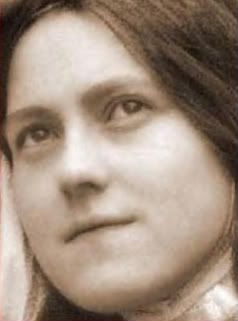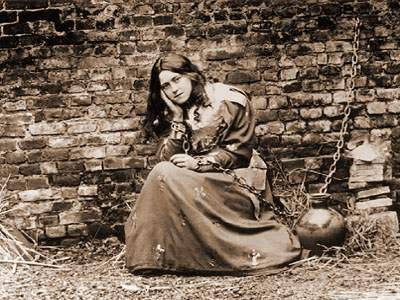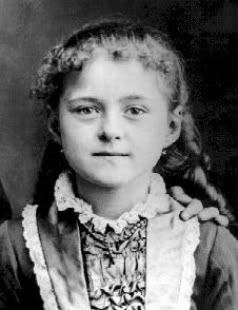I think I came across this video for the first time a few years ago. I remember Nick Cannon on Nickelodian as I was growing up. He has a beautiful story and I think this video telling it is very well done and thought I should share.
The Faith, Art, and Theology of the Body blog of Shana Smith...and the Word became flesh... (John 1:14)

Tuesday, September 28, 2010
Watercolor
Saturday, September 18, 2010
On Being a Nun
I came across this video a good while ago and really enjoyed it. Recently I found this sister on facebook (she commented on a friend's post), so she came to mind again. Just wanted to share, something about this one just makes me happy. Though I need to limit myself on these because there are a lot of videos related to religious sisters I could put up and I wouldn't want to go overboard! Enjoy!
A Catholic World View & Art
I was fortunate enough to come across this video today which is episode two (the most recent one out) of a program called The Way of Beauty by David Clayton.
You can learn more about the program and watch archived episodes here. I liked this second episode best myself as it directly addressess an issue I was pondering in my previous post Fill These Hearts; Sacred and Secular Art where I was seeking to understand what sacred art is and how it relates to artwork that glorifies God but may not be in the category of "sacred art". I found that his treatment was very affirming of all art that brings glory to God and open while at the same time maintaining important distinctions. I like what Clayton has to say on the issue thus far and am looking forward to follow his exploration of this subject in this series. Clayton proposes that good art is beautiful and true. While this may seem at first to be too narrow a view, he notes that a piece of art could depict even a horrendous subject such as suffering yet still be beautiful if it proposes also hope. In other words good art needs to be real and need not shy away from the messiness of real life in order to be beautiful. This brings us to truth, which can be approached by different angles. For example art that may not be as true to life in the sense of being naturalistic could be true even in abstracted styles or are less "literal". We see this for example in iconography, which is seeking the truth but by a different path, or is exploring another dimension of truth. This point of truth in art is something I've been thinking about in regard to my own art and I plan to write on that soon.
You can learn more about the program and watch archived episodes here. I liked this second episode best myself as it directly addressess an issue I was pondering in my previous post Fill These Hearts; Sacred and Secular Art where I was seeking to understand what sacred art is and how it relates to artwork that glorifies God but may not be in the category of "sacred art". I found that his treatment was very affirming of all art that brings glory to God and open while at the same time maintaining important distinctions. I like what Clayton has to say on the issue thus far and am looking forward to follow his exploration of this subject in this series. Clayton proposes that good art is beautiful and true. While this may seem at first to be too narrow a view, he notes that a piece of art could depict even a horrendous subject such as suffering yet still be beautiful if it proposes also hope. In other words good art needs to be real and need not shy away from the messiness of real life in order to be beautiful. This brings us to truth, which can be approached by different angles. For example art that may not be as true to life in the sense of being naturalistic could be true even in abstracted styles or are less "literal". We see this for example in iconography, which is seeking the truth but by a different path, or is exploring another dimension of truth. This point of truth in art is something I've been thinking about in regard to my own art and I plan to write on that soon.
Saturday, September 11, 2010
To the Pure All Things Are Pure


St. Therese as St. Joan of Arc in a play
I've been sort of bad at checking my gmail, yesterday I came across an email that Sr. Helena sent me earlier this month which was forwarded from another sister in her congregation, Sr. Lorraine. Sr. Lorraine has been following and responding to the whole Theology of the Body related debate concerning how far through Christ are we able to overcome concupiscience. An illustration of this controversy would be all the criticism Christopher West has gotten this past year relating to this point. His response to some of the criticism he has recieved can be read here for those unfamiliar with what I'm referencing. Basically my take on this issue is that while some criticisms of West's work have been constructive and have helped him refine his approach to interpreting and presenting TOB, some critics misinterpret and misrepresent his work or aspects of his work. There are some relatively minor points of Christopher West's work where I'm not sure where I stand yet, I need to conduct more research, but I feel that he is pretty much on the mark in regards to the issue of Christ's power to overcome lust.
Christ gives us real power to redeem the way we perceive the human body, and real power to overcome lust. This isn't to say that the temptation to lust will not always be there, just that through Christ there is real power to achieve a real change in our hearts from lust towards love, in our vision of the human body from distortion towards reintegration. This issue really involves me as an artist who represents the human body (often unclothed!) in my work. There are those who believe that it is never appropriate to make or view art which has as its subject the unclothed figure, thinking that the naked human body will always be an occasion for lust. I believe that presenting the human body in a respectful way that seeks after the whole truth of man who is made in the image of God (and who's body speaks of this in its inscribed call to self-gift and communion with the other) is healing in that it aids reintegrating our vision of the human body which has become distorted through pornography (which instead of seeking after truth pursues and presents lies about the human person and sexuality). Now this doesn't mean that an artist representing the human body, even with the best of intentions, doesn't need to be discerning in the way they present their subject and the means through which they display their work for the human body is a loaded and sensitive subject, this is process is on-going for me and I feel I have a lot more to learn. More on this later.
Back to the email, Sr. Lorraine, trying to clear her head of this TOB debate, went to read the autobiography of St. Therese of Lisieux. But there's no getting away from TOB, in her reading, much to her surprise she came across this passage, concerning the the saint's trip to Rome:
I prayed Our Lady of Victories to keep far from me everything that could tarnish my purity; I was fully aware that on a voyage such as this into Italy I could easily meet with things capable of troubling me. I was still unacquainted with evil and so was apprehensive about makings its discovery. I had not yet experienced that to the pure all things are pure (Titus 1:15), that the simple and upright soul sees evil in nothing since it resides only in impure hearts, not in inanimate objects.” (Story of a Soul, chapter 6, pg. 123).
This blew Sr. Lorraine away in the way it summed up what this whole debate on purity of heart is about. St. Therese was concerned about all the art with naked people, and then came to realize how one who is pure of heart can perceive the human body in purity rather than have it be an occasion for lust. St. Therese is famous for her child-like faith, perhaps there is connection with child-like purity in seeing the human body?


I'm grateful for Sr. Helena forwarding this to me, perhaps St. Therese should be special patron of mine now?
St. Therese of Lisieux- Pray for us.
OK, now for some art...
So it's been a while since I've put any of my art up on this blog, seeing as how this summer wasn't exactly the most productive one as far as making art is concerned. But now that I'm back at art school there should be more regular postings of what I've been working on. I've been sitting in on one of my professor's figure drawing classes. Last time he was having his students sketch and draw with india ink, so I figured I'd give it a go to try out something new, for I don't recall ever making drawings from life with straight up ink and brush. I found myself liking it. I liked how fast an image could come together with the bold black of the ink. I really also think it's a helpful medium for me to use to help me loosen up and paint more spontaneously as drawing with ink requires a certain boldness (no erasing!). The first was a three minute sketch and the other three were 15 minute drawings. To achieve lighter values I drybrushed. Would be a little different effect if I were to use washes, sort of like watercolor. Perhaps sometime I'll experiment with ink washes, would be a good preparation for watercolor painting. Watercolor painting is something I never really got into but I think I'd like to experiment with it a little, if only I use it mostly for sketches.




More art on the way!




More art on the way!
Subscribe to:
Posts (Atom)
